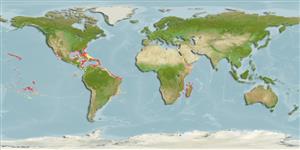Common names from other countries
Élasmobranches (requins et raies) (sharks and rays) >
Squaliformes (Sleeper and dogfish sharks) >
Squalidae (Dogfish sharks)
Etymology: Cirrhigaleus: Latin, cirrus = curl fringe + Greek, galeos = a shark (Ref. 45335).
Issue
Genus B. Mundy, pers. comm.
Environment: milieu / climate zone / depth range / distribution range
Écologie
marin bathydémersal; profondeur 200 - 650 m (Ref. 55584). Deep-water; 35°N - 35°S, 171°W - 51°E (Ref. 55304)
Western Atlantic: North Carolina to the Florida Keys (Ref. 3814) and the northern Gulf of Mexico. Western Indian Ocean: southern Mozambique to South Africa; also Reunion, Comoros, and the Aldabra islands (Ref. 33390). Eastern Central Pacific: Hawaiian Islands.
Length at first maturity / Taille / Poids / Âge
Maturity: Lm 110.0 range ? - ? cm
Max length : 120 cm TL mâle / non sexé; (Ref. 247); 115.0 cm TL (female)
Épines dorsales (Total) : 2; Épines anales: 0. A heavy-bodied dogfish with a blunt, rounded snout, large denticles and noticeably rough skin; body without spots; 1st dorsal fin spine behind pectoral fins (Ref. 5578). Dark grey or brown above, lighter below; white edges on fins (Ref. 5578); juveniles brown (Ref. 6577).
Found on the upper continental and insular slopes (Ref. 247). Adults feed on bony fishes and squids (Ref. 5213). Ovoviviparous (Ref. 205), with 21 to 22 young in a litter (Ref. 247).
Ovoviviparous, with 21 to 22 young in a litter.
Compagno, L.J.V., 1984. FAO Species Catalogue. Vol. 4. Sharks of the world. An annotated and illustrated catalogue of shark species known to date. Part 1 - Hexanchiformes to Lamniformes. FAO Fish. Synop. 125(4/1):1-249. Rome, FAO. (Ref. 247)
Statut dans la liste rouge de l'IUCN (Ref. 130435)
CITES (Ref. 128078)
Not Evaluated
Menace pour l'homme
Harmless
Utilisations par l'homme
Pêcheries: sans intérêt
Outils
Articles particuliers
Télécharger en XML
Sources Internet
Estimates based on models
Preferred temperature (Ref.
115969): 9.7 - 18.4, mean 13.4 (based on 113 cells).
Phylogenetic diversity index (Ref.
82804): PD
50 = 0.6250 [Uniqueness, from 0.5 = low to 2.0 = high].
Bayesian length-weight: a=0.00355 (0.00171 - 0.00737), b=3.10 (2.92 - 3.28), in cm Total Length, based on LWR estimates for this (Sub)family-body shape (Ref.
93245).
Niveau trophique (Ref.
69278): 4.5 ±0.62 se; based on food items.
Résilience (Ref.
120179): Faible, temps minimum de doublement de population : 4,5 à 14 années (Fec=21-22).
Fishing Vulnerability (Ref.
59153): High to very high vulnerability (72 of 100).
